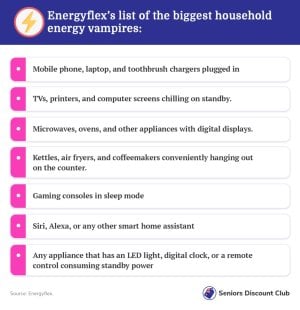These everyday gadgets at home are secretly skyrocketing your energy bill!
By
Danielle F.
- Replies 12
In the age of technology, our homes are filled with gadgets and appliances that promise to make life easier and more entertaining.
However, as we embrace these modern conveniences, we must know the hidden costs they bring to our energy bills.
It's time to expose the everyday gadgets that secretly drain wallets and show you how you can take control and save money on your power bill.
The term 'energy vampires' might sound like something out of a horror movie. Still, it's a genuine phenomenon affecting households across Australia.
These vampires are the appliances and devices in your home that continue to consume electricity even when turned off or in standby mode.
This 'phantom load' can significantly contribute to your energy bill, and it's often overlooked because the costs are not immediately apparent.
Garry Harding, co-founder and Chief Executive of energy analytics company EnergyFlex, identified some energy vampires that may feed off electricity.
Smart TVs, gaming consoles, and internet modems are among the top culprits, quietly syphoning off power and money.
For example, a smart TV can consume 12W per hour while on standby—possibly adding an extra $34.69 to your annual energy bill.
Considering all the devices in your home, this can add up to an additional $104-176 each year.
While the Federal Government's $300 energy rebate from July 1 may offer some relief, it's a temporary fix to a persistent problem.
To combat these hidden costs, consumers must understand how electricity use works and take proactive steps to reduce it.
One of the most straightforward solutions is to switch off power boards or outlets when devices are not in use.
This can cut off the power supply to your gadgets, preventing them from drawing unnecessary energy.
For those looking for a more high-tech solution, smart switches can be installed. These switches allow you to control your devices remotely through your mobile phone.
This helps you save energy and adds a layer of convenience to managing your home's power usage.
EnergyFlex's app on iOS and Android also provides practical tips and a rating system that measures the impact on the power grid and your household's ability to use renewable energy when available.
Another tip to consider is being mindful of 'peak usage' times.
Electricity prices are higher during these periods due to increased demand.
Running appliances like dishwashers during 'off-peak' times can save you much more than the government rebate offers.
Federal Treasurer Jim Chalmers has emphasised that the rebate is not about 'spraying cash around'. but rather providing targeted assistance to ease the cost-of-living pressures.
However, taking control of your energy consumption can go beyond temporary relief and achieve lasting savings.
While technology has brought countless benefits to our lives, it's essential to be aware of the hidden costs associated with our gadgets.
By identifying your home's energy vampires and taking steps to reduce their impact, you can save money and contribute to a more sustainable future.

Do you have any 'energy vampires' at home? If so, please share your experiences and power-saving tips in the comments below.
However, as we embrace these modern conveniences, we must know the hidden costs they bring to our energy bills.
It's time to expose the everyday gadgets that secretly drain wallets and show you how you can take control and save money on your power bill.
The term 'energy vampires' might sound like something out of a horror movie. Still, it's a genuine phenomenon affecting households across Australia.
These vampires are the appliances and devices in your home that continue to consume electricity even when turned off or in standby mode.
This 'phantom load' can significantly contribute to your energy bill, and it's often overlooked because the costs are not immediately apparent.
Garry Harding, co-founder and Chief Executive of energy analytics company EnergyFlex, identified some energy vampires that may feed off electricity.
Smart TVs, gaming consoles, and internet modems are among the top culprits, quietly syphoning off power and money.
For example, a smart TV can consume 12W per hour while on standby—possibly adding an extra $34.69 to your annual energy bill.
Considering all the devices in your home, this can add up to an additional $104-176 each year.
While the Federal Government's $300 energy rebate from July 1 may offer some relief, it's a temporary fix to a persistent problem.
To combat these hidden costs, consumers must understand how electricity use works and take proactive steps to reduce it.
One of the most straightforward solutions is to switch off power boards or outlets when devices are not in use.
This can cut off the power supply to your gadgets, preventing them from drawing unnecessary energy.
For those looking for a more high-tech solution, smart switches can be installed. These switches allow you to control your devices remotely through your mobile phone.
This helps you save energy and adds a layer of convenience to managing your home's power usage.
EnergyFlex's app on iOS and Android also provides practical tips and a rating system that measures the impact on the power grid and your household's ability to use renewable energy when available.
Another tip to consider is being mindful of 'peak usage' times.
Electricity prices are higher during these periods due to increased demand.
Running appliances like dishwashers during 'off-peak' times can save you much more than the government rebate offers.
Federal Treasurer Jim Chalmers has emphasised that the rebate is not about 'spraying cash around'. but rather providing targeted assistance to ease the cost-of-living pressures.
However, taking control of your energy consumption can go beyond temporary relief and achieve lasting savings.
While technology has brought countless benefits to our lives, it's essential to be aware of the hidden costs associated with our gadgets.
By identifying your home's energy vampires and taking steps to reduce their impact, you can save money and contribute to a more sustainable future.
Key Takeaways
- EnergyFlex co-founder and expert Garry Harding highlighted that everyday appliances like Smart TVs, gaming consoles, and internet modems contribute to significant power costs due to 'phantom load'.
- While the Federal Government is offering a $300 energy rebate to provide some relief, Harding advises that households can save even more by being aware of and reducing phantom load.
- Standby power can result in additional costs – up to an annual extra cost of $34.69 from a Smart TV on standby alone – with a range of appliances contributing to an extra $104-176 a year on power bills, depending on the state.
- Simple measures like turning off power boards or outlets or using smart switches can reduce unnecessary energy consumption.
- Being conscious of peak and off-peak electricity usage times can lead to further savings.









